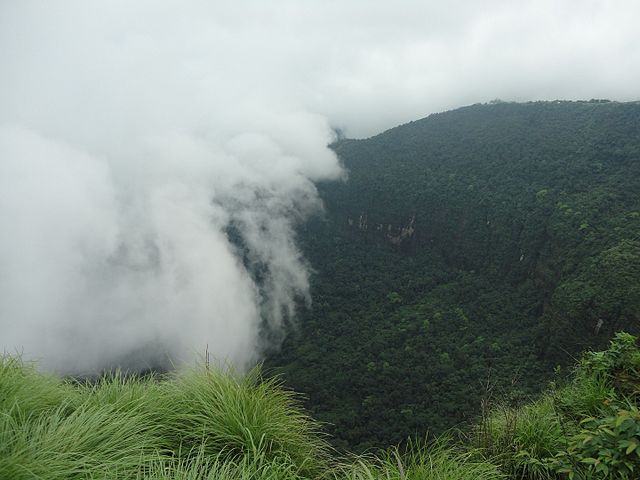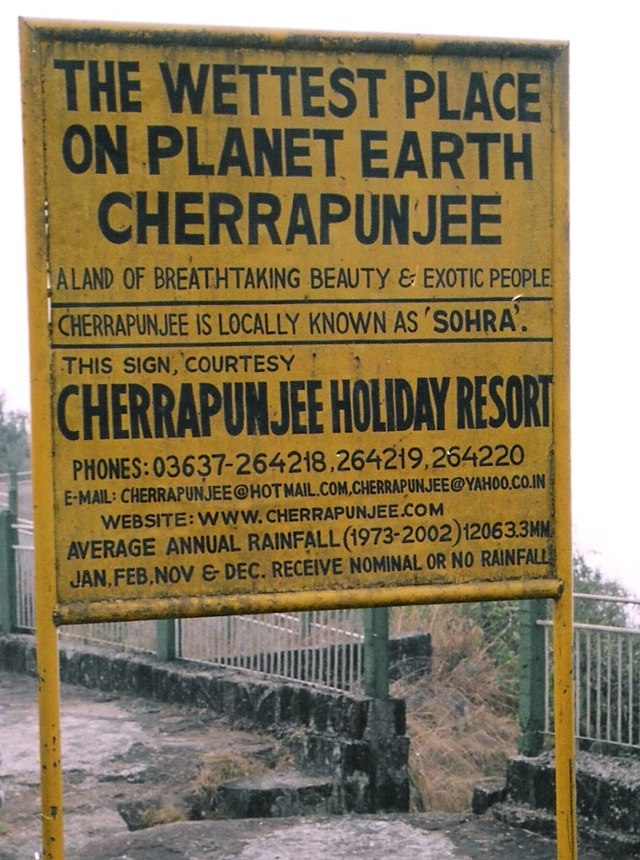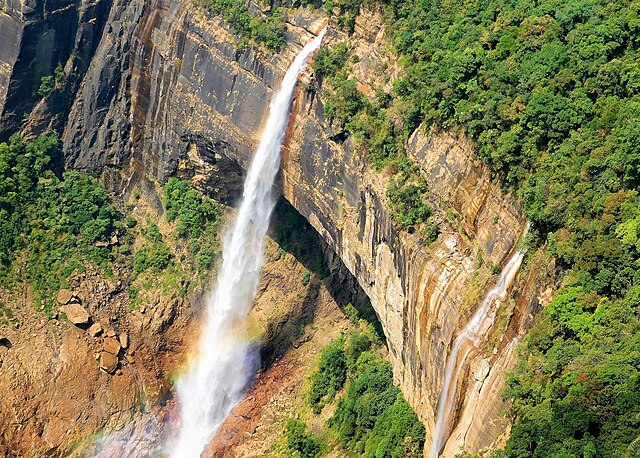Have you ever wondered what it’s like to live in a place where rain isn’t just weather—it’s a way of life? Welcome to Cherrapunji, a small town in India that holds the mind-boggling record for being the wettest place on Earth. This isn’t your typical vacation spot where you worry about forgetting sunscreen. Here, umbrellas are practically body armor, and the sound of raindrops becomes the soundtrack of daily life.
Imagine standing in a place where the clouds literally touch the ground, where waterfalls cascade from heights that make your knees weak, and where the very air you breathe is thick with moisture. That’s Cherrapunji for you—a destination that challenges everything you think you know about weather and human adaptation.
What Makes Cherrapunji So Special?
The Geography Behind the Rain
Picture this: you’re standing on the edge of the world, looking down at Bangladesh’s sprawling plains while monsoon clouds roll in like nature’s own freight train. That’s the magic of Cherrapunji’s location. Perched at about 4,823 feet above sea level on the Shillong Plateau, this town sits right in the path of moisture-laden winds from the Bay of Bengal.
The geography here isn’t just beautiful—it’s a perfect storm creator. The steep slopes of the Khasi Hills act like a giant funnel, forcing warm, humid air upward where it cools rapidly and dumps its moisture content. It’s like nature’s own rain-making machine, working 24/7 during monsoon season.
Record-Breaking Rainfall Statistics
Let’s talk numbers that’ll make your jaw drop. Cherrapunji doesn’t just get a lot of rain—it gets an absolutely ridiculous amount. We’re talking about a place that once recorded 905 inches of rainfall in a single year. To put that in perspective, that’s more than 75 feet of water falling from the sky!
The town holds the world record for the most rainfall in a single year (1861) and the most rainfall in a single month. During peak monsoon months, residents can experience over 100 inches of rain in just 30 days. That’s like getting an entire year’s worth of rain in most places, compressed into four weeks.
Where Exactly is Cherrapunji Located?
Nestled in Meghalaya’s Hills
Cherrapunji, also known locally as Sohra, is tucked away in the East Khasi Hills district of Meghalaya, one of India’s northeastern states. The name “Meghalaya” literally means “abode of clouds,” and once you visit Cherrapunji, you’ll understand why this name couldn’t be more perfect.
This isn’t just any hill station—it’s positioned strategically where the Indian subcontinent meets the Tibetan plateau, creating a unique microclimate that’s unlike anywhere else on Earth. The town overlooks the plains of Bangladesh, offering breathtaking views when the clouds part (which, let’s be honest, doesn’t happen very often).
Getting There: Your Journey to the Clouds
Reaching Cherrapunji is an adventure in itself. The nearest airport is in Guwahati, about 150 kilometers away, followed by a scenic but winding road journey through some of the most beautiful landscapes you’ll ever see. As you climb higher into the hills, you’ll notice the air getting cooler and more humid, and suddenly you’re driving through actual clouds.
The journey from Shillong, the state capital, takes about 1.5 hours by road. But here’s a pro tip: take your time and enjoy the ride. The route is dotted with viewpoints that offer stunning vistas of valleys shrouded in mist and mountains that seem to touch the sky.
The Science of Cherrapunji’s Extreme Weather

Monsoon Magic: How Nature Creates a Waterfall from the Sky
Ever wondered how one small town can attract so much rain? It’s all about location, location, location—and a bit of meteorological magic. Cherrapunji sits right in the path of the southwest monsoon winds that sweep in from the Bay of Bengal, loaded with moisture.
Think of it like this: imagine you’re holding a garden hose pointed at a wall. The water hits the wall and splashes everywhere, right? That’s essentially what happens when moisture-laden clouds hit the steep slopes of the Khasi Hills. The air is forced upward rapidly, cooling as it rises, and all that moisture has nowhere to go but down.
The Role of the Himalayas
The mighty Himalayas play a crucial supporting role in Cherrapunji’s weather drama. These massive mountains act like a giant barrier, trapping monsoon clouds and forcing them to dump their contents before they can move further north. It’s like nature’s own dam, except instead of holding back water, it’s holding back clouds.
Bay of Bengal’s Contribution
The Bay of Bengal is like Cherrapunji’s personal rain supplier. This warm body of water acts as a massive evaporation pool, sending up tons of moisture into the atmosphere. When these moisture-rich winds hit Cherrapunji’s hills, it’s game over—time for another record-breaking downpour.
Life in the Land of Eternal Rain
How Do People Actually Live Here?
You might be wondering: how do people actually function in a place where it rains almost constantly for months? The answer lies in incredible human adaptability and generations of wisdom passed down through local communities.
Houses in Cherrapunji are built with steep, slanted roofs that shed water quickly. Many homes are elevated on stilts to avoid flooding, and locals have developed ingenious water management systems. It’s like living in a perpetual state of preparedness for nature’s daily shower.
Local Culture and Traditions
The constant rain has shaped not just the landscape but the culture itself. Local festivals often revolve around monsoon seasons, and traditional songs frequently reference the relationship between the people and the rain. It’s fascinating how weather can become so deeply embedded in a community’s identity.
The Khasi Tribe’s Amazing Adaptations
The indigenous Khasi people have been living in harmony with Cherrapunji’s extreme weather for centuries. They’ve developed unique architectural styles, agricultural practices, and even social customs that revolve around the monsoon cycle. Their traditional bamboo and thatch houses are perfectly adapted to handle months of continuous rainfall.
Tourist Attractions That’ll Blow Your Mind
Living Root Bridges: Nature’s Engineering Marvel
Here’s something that’ll make you question everything you know about bridge construction. The Khasi people have been growing bridges—yes, growing them—using the aerial roots of rubber trees. These living root bridges can support the weight of 50 people and actually get stronger over time.
The most famous is the double-decker root bridge in Nongriat village, which takes about 3,000 steps to reach. It’s like something straight out of a fantasy movie, except it’s real and you can walk across it.
Waterfalls That Put Niagara to Shame
With all that rain, you’d expect some impressive waterfalls, right? Cherrapunji doesn’t disappoint. The sheer volume and variety of waterfalls here will leave you speechless.
Nohkalikai Falls
At 1,115 feet, Nohkalikai Falls is India’s tallest plunge waterfall. During monsoon season, this cascade becomes a thundering beast that you can hear from miles away. The water plunges into a deep pool that changes color from blue to green depending on the season—it’s like nature’s own mood ring.
Seven Sisters Falls
Also known as Nohsngithiang Falls, this spectacular waterfall consists of seven separate streams cascading down the cliff face. During peak monsoon, all seven streams merge into one massive waterfall that’s visible from several kilometers away.
Best Time to Visit Cherrapunji

Monsoon Season: For the Brave Hearts
If you’re the type who finds beauty in chaos, monsoon season (June to September) is your time. This is when Cherrapunji truly lives up to its reputation. You’ll witness nature at its most dramatic, but be prepared for limited visibility, difficult travel conditions, and the constant need for waterproof everything.
Post-Monsoon: The Sweet Spot
October to February is considered the best time to visit. The rains have subsided (mostly), the air is crystal clear, and you can actually see those stunning views everyone talks about. The weather is pleasant, perfect for trekking and exploring the famous attractions.
The Irony of Water Scarcity
Too Much Rain, Not Enough Water?
Here’s a mind-bending paradox: the wettest place on Earth faces water shortages during the dry season. How is that even possible? The answer lies in the region’s rocky terrain and poor water retention capacity.
Most of the rainwater simply runs off the steep slopes into Bangladesh, leaving locals struggling for clean drinking water during the dry months. It’s like being surrounded by food but having nothing to eat—frustrating and ironic in equal measure.
Climate Change and Cherrapunji’s Future
Climate change is already affecting Cherrapunji’s rainfall patterns. Scientists have observed changes in monsoon timing and intensity, which could impact everything from local agriculture to tourism. The challenge is adapting to these changes while preserving what makes this place so unique.
Some years now see even more extreme rainfall, while others experience unusual dry spells. It’s like nature is experimenting with new weather patterns, and Cherrapunji is the testing ground.
Planning Your Trip: Practical Tips
Where to Stay
Accommodation options range from budget guesthouses to eco-resorts. Many places offer stunning valley views, but book in advance, especially during the post-monsoon tourist season. Some hotels even provide rain gear as part of their service—that’s how seriously they take the weather here.
What to Pack
Pack like you’re going to live underwater for a week. Waterproof everything: shoes, bags, camera covers, and clothes. Quick-dry fabrics are your best friend. Don’t forget a good pair of trekking shoes with excellent grip—those wet rocks can be treacherous.
Layers are essential because temperatures can vary dramatically between sunny spells and heavy downpours. And yes, bring multiple umbrellas—they tend to give up under Cherrapunji’s relentless rain.
Conclusion
Cherrapunji isn’t just a destination; it’s an experience that challenges your relationship with nature itself. This remarkable place shows us how humans can adapt to even the most extreme conditions while maintaining their cultural identity and connection to the land.
Whether you’re drawn by the record-breaking rainfall, the stunning landscapes, or the unique cultural experiences, Cherrapunji offers something that no other place on Earth can match. It’s a reminder of nature’s incredible power and our remarkable ability to not just survive but thrive in harmony with it.
Sure, you’ll get wet—really, really wet. But you’ll also witness something truly extraordinary: a place where rain isn’t just weather, it’s the very essence of life itself. And isn’t that worth a little moisture?
Frequently Asked Questions
1. Is it safe to visit Cherrapunji during monsoon season? While it’s possible to visit during monsoon season, it requires careful planning and preparation. Road conditions can be challenging, visibility is often poor, and some attractions may be inaccessible. If you do visit during this time, stick to established accommodations and avoid unnecessary travel during heavy downpours.
2. How much does it cost to visit Cherrapunji? Cherrapunji is quite budget-friendly for tourists. Accommodation ranges from ₹500-3000 per night, local food is affordable, and most natural attractions are free. The main expense is usually transportation, especially if you’re hiring private vehicles for sightseeing.
3. Can you see the living root bridges year-round? Yes, the living root bridges are accessible throughout the year, though the trek can be more challenging during monsoon season due to slippery paths. The post-monsoon period (October-February) offers the best conditions for visiting these natural wonders.
4. What’s the difference between Cherrapunji and Mawsynram? While Cherrapunji holds historical rainfall records, nearby Mawsynram currently receives slightly more annual rainfall on average. Both towns are in the same region and offer similar experiences, but Cherrapunji has better tourist infrastructure and more developed attractions.
5. Do I need special permits to visit Cherrapunji? Indian citizens don’t need any special permits to visit Cherrapunji. Foreign tourists need standard Indian visas but no additional permits for Cherrapunji itself. However, if you plan to visit nearby restricted areas or cross into Bangladesh viewpoints, check current regulations as they can change.

